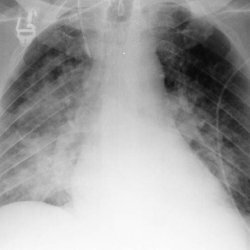Bronchospastic syndrome: symptoms and treatment
 Bronchospastic syndrome( bronchospasm) is a symptom complex characterized by a contraction of the muscles of the bronchi and bronchioles. This syndrome is a secondary nature, which causes a sharp increase in the energy expended per unit of pulmonary ventilation and an increase in the work of the respiratory muscles. In other words, a person can inhale and inhale air, but can not exhale due to narrowing of the bronchi. If at this dangerous moment he is not given the first emergency aid, he may die because of a shortage of air.
Bronchospastic syndrome( bronchospasm) is a symptom complex characterized by a contraction of the muscles of the bronchi and bronchioles. This syndrome is a secondary nature, which causes a sharp increase in the energy expended per unit of pulmonary ventilation and an increase in the work of the respiratory muscles. In other words, a person can inhale and inhale air, but can not exhale due to narrowing of the bronchi. If at this dangerous moment he is not given the first emergency aid, he may die because of a shortage of air.
Bronchospastic condition is caused by various causes:
- reactions caused by allergens;
- direct exposure to some chemicals and increased carbon dioxide in the alveolar air;
- various reflex effects on the fibers of the vagus nerve, which during the stimulation cause reflex bronchospasm.
Bronchospastic syndrome can be of three types: total, diffuse and local. Persistent diffuse bronchospasm develops respiratory failure, hypoxia and hypercapnia, which only increase the development of the syndrome. With total bronchospasm, the patient is transferred to artificial ventilation because of the ineffectiveness of the efforts of the respiratory muscles.
Symptoms of bronchospastic state
Syndrome may be preceded by the following symptoms: mood swings, coughing, anxiety, sleep disturbance, liquid discharge from the nose.
Immediate symptoms are: difficulty in breathing, prolonged exhalation, feeling of heaviness and stuffiness in the chest, a person may experience shortage of air, increase the tone of the respiratory muscles, wheezing, cyanosis of the mucous membranes, pallor of the face, circles under the eyes of the blue hue. Bronchospasm is accompanied by shortness of breath. The patient with difficulty coughs, can not release the lungs from phlegm. This is due to the narrowing of the bronchi and the violation of their patency.
Diagnosis
Complaints: difficulty breathing, attacks of suffocation and expiratory dyspnea. During the examination procedure, the patient should take a position, standing or sitting and leaning on his hands. The doctor diagnoses cyanosis and swelling of the cervical veins, chest widening, as if the patient constantly inhales. Further - the smoothness of the subclavian pits, the intercostal space, frequent breathing and a short inhalation through the mouth, the exhalation is short.
The doctor examines and diagnoses the function of external respiration( FVD).It determines the volume of the forced exhalation per second and the vital capacity of the lungs. It is the ratio of these indicators( the so-called Tiffno index) that determines the degree of patency of the bronchi.
In other words, this diagnosis is as follows:
- The initial function of external respiration is investigated;
- One dose of berotek is inhaled with a metered pocket aerosol;
- After 20 minutes, the function of external respiration is examined once more.
Of course, we can not do without laboratory and instrumental research. Clinical and biochemical blood analysis, microscopic and microbiological examination of sputum are carried out. The following modern diagnostic methods are also used:
- Capnography. With the help of this method, the doctor estimates the depth of breathing based on the volume of carbon dioxide in the exhaled sick air. Capnography can be used both at rest and during exercise, and also monitor changes in breathing during recovery.
- Bronchophonography. It is a computer-based acoustic complex "Pattern-01".The method of computer bronchophonography is one of the most modern possibilities to investigate the function of breathing in children since birth, which was previously impossible. This method allows to detect the violation of breathing in children in a calm state and even during sleep. It provides essential help in the excessive formation of sputum, difficulty in nasal breathing and in diagnosing the causes of childhood cough.
- Pulse oximetry. This method determines the amount of oxygen contained in the blood, as well as the pulse rate, the change of which is observed during the course of the syndrome, and improvement in case of timely treatment.
Possible prognosis and complications
The prognosis for the bronchospastic state is quite favorable. But it is very important to take into account the disease that caused this spasm, and begin treatment, otherwise the consequences can be very serious.
Treatment of bronchospasm
Currently, doctors have at their disposal many tools that can prevent the release of active biological substances that are formed in the human body as a result of allergic reactions, resulting in a spasm of bronchial muscles. As a rule, they are used for prevention purposes. There are tools that can stimulate adrenoreceptors, the use of which relaxes the smooth muscles of the bronchi. In addition to these drugs, the complex treatment of bronchospastic syndrome includes the use of glucocorticoids. All this proves once again that each medicine has its own sphere of influence. Therefore, in no case should you take this or that drug, listening to the advice of friends and neighbors. As a result of self-medication, you can seriously damage your body and cause complications. Every person is different. And only a doctor can prescribe a specific drug based on the existing symptoms of the disease.
To date, in addition to tablets, ampoules and suppositories, metered aerosols containing preparations capable of expanding bronchi are widely used. The drug, which is administered by inhalation with a pocket inhaler, comes directly to the bronchi and lungs. Thus, it became possible to create the necessary drug concentrations not in the blood, but directly in the respiratory tract, thereby preventing possible reactions from other systems of the human body.
But at the same time in the use of a pocket inhaler there are some disadvantages. There are cases when the aerosol is used almost uncontrollably, that is much more often than the specialist prescribed. These rash actions lead to a drug overdose, causing various side effects. Therefore, the tactics of the patient, in the event of an attack of suffocation, should be as follows:
- First, the arisen attack of suffocation must be urgently eliminated. If these actions are not taken, the process of sputum formation will increase, thereby worsening the patency of the bronchi.
- Secondly, before the inhalation it is necessary to shake the balloon, bring it to the mouth at a distance of 2-3 cm, make a full exhalation and press the outlet valve simultaneously through the mouth to inhale the aerosol.
- After this, you need to try to hold up the exhalation for a long time. Only then the particles of the drug settle on the mucous membrane of the bronchi and manifest their action. After 20-30 seconds, the improvement will already be felt. This action can be repeated.



